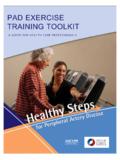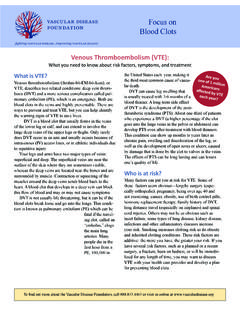Transcription of Congenital Vascular Malformation
1 What is Congenital VascularMalformation?Birthmarks, Vascular Malformations and AnomaliesVascular anomalies occur in barely 1 percent of all , because of their rarity, their proper diagnosis andtreatment is difficult, as most physicians do not see theseproblems often enough to become knowledgeable abouttheir are they? Vascular anomalies is an all-inclusive term for Vascular malformations, Vascular tumors and other Congenital vas-cular defects. The more commonly used term, Congeni-tal Vascular Malformation (CVM), implies abnormally formed blood vessels that one is born with. However, in spite of its redundancy, CVM is a popular term and it will be used here. Birthmarks occur on the surface of the body and arerelatively easy to deal with. Other Vascular malforma-tions can develop from any type of blood vessel and develop in any part of the body, although most involve the extremities.
2 They represent defects or development problems that occurred during embryonic growth. De-pending on the state of development at the time this oc-curs, the result can involve arteries, veins, lymph vessels, or combinations of difference between a CVM and a Vascular tumor orhemangioma (the medical term), both of which are com-monly called birthmarks, is very important to a they may initially appear the same, all birth-marks are not the same. Most birthmarks represent asuperficial Vascular Malformation , consisting of abnor-mal collections of small blood vessels near the Vascular Vascular HEALTHC ongenital Vascular MalformationTypically, this CVM type of birthmark does not goaway nor does it enlarge, growing only at the same rate as the child. It thus maintains the same size and appear-ance indefinitely, is not a health threat and requires noimmediate treatment.
3 Some birthmarks, because of theirlocation, particularly around the face and neck or on some other exposed body part, may be considered unsightly. Fortunately, the characteristic reddish color coincides with the range of certain lasers that can be used for their removal. Another approach has been to cover them up by tattooing them a skin color. The other type of birthmark may appear the same atfirst, but is actually a Vascular tumor or hemangioma. Incontrast, this type grows rapidly in the months after itsdiscovery, but then it involutes or gets progressivelysmaller. The majority disappear completely in a fewyears, leaving behind a patch of shrunken elastic regression normally is competed between two andeight years of age, but not all of them completely disap-pear. During their growth phase, these juvenile heman-giomas can be alarming, particularly if they grow in acritical location, such as those on the face impinging onthe eye, nose, or mouth, in which case they may requiretreatment.
4 However, most juvenile hemangiomas do notrequire treatment. Rather the best advice is to do nothingbut wait it out, giving it a chance to go away by of these types of birthmarks, or the remnants ofthem, can be greatly improved in appearance by plasticsurgery, but this is only occasionally needed and canusually be done after the child grows find out more about the Vascular Disease Foundation, call or visit us online at is CongenitalVascularMalformation?Arterial- Venous CVMsOther CVM are formed during early developmental stages when large con-necting channels or shunts between future arteries and veins exist and for some unknown reason these artery-to-vein connections, or a cluster of them persist. Such connections are called arteriovenous fistulas (AVFs), or if there is a cluster of them they are called arteriovenous malformations (AVMs).
5 These are potentially the most serious type of CVMs because in shunting blood from arteries to veins, they bypass the small vessels that make up the normal circulation beyond that point. This not only robs or steals blood that would otherwise pass through to more distant tissues and nourish them, but doesn t allow for a gradual pressure drop from the high arterial pressure to the low pres-sure on the venous side. Thus, these AVFs represent a high flow shortcir-cuit and, depending on their size and location, they may force the heart to work harder. They may also cause poor circulation in the limb beyond the point of the AVF. In time, these AVFs tend to get bigger and have greater effect on the circula-tion. For example, and AVF or AVM in an extremity can steal (reduce) blood flow to a foot or hand as much as a blocked artery would.
6 Fortunately, AVFs located in the legs and arms are more common than elsewhere in the body and thus easier to deal with. Those involving pelvic ves-sels, or vessels to vital organs or the brain can be extremely difficult to treat without injuring the organs or tissues surrounding them. Although AVFs make up only one third of all CVMs, they attract the most attention because of the serious problems they create, and are the CVMs most likely to need interventional CVMsCVMs composed entirely of veins are the most common,comprising almost half of the total, and are of two basic types. The more primitive ones appear as thinwalledlakes in which venous blood collects and when they devel-op in groups or clusters, they may form a mass consisting of a collection of grape-like clusters of these venous lakes. This type usually does not affect the venous circulationwhich returns blood to the heart, but these Malformation can be unsightly, cumber-some or be the site of a type of blood clot (not the type that travel to the heart or lungs).
7 They are not a serious threat, but may be worth treating if the mass is large and causes local problems, for example, interfering with walking. The other type of venous defect in-volves the large deep or central veins and often interferes with their function. Seg-ments of major veins may be absent or narrowed. Some seg-ments may be greatly widened and expand-ed (dilated), called a venous aneurysm. Treatment depends upon how severely they affect venous return or contribute to deep vein thrombo-sis (DVT). Most of the venous malformations involve only short venous segments and do not require CVMsCVMs of the arteries are the least common and responsiblefor only one to two percent of the total. The most common arterial defect involves a segment that did not develop. The result is that a normal arterial segment is missing and instead blood flows through an undeveloped side chan-nel or collateral artery, which persists rather than withers.
8 Although this allows a bypass of the blockages, the en-larged bypassing segment often becomes more vulnerable to compression and injury, developing into an aneurysm or suddenly clotting off. The most common example of this is the so-called persistent sciatic artery. 2012 Vascular DISEASE FOUNDATION 8206 Leesburg Pike, Suite 301 Vienna, VA 22182 07vdf2012 Symptoms of CVMWhen located in an extremity, CVMs may show up as abirthmark, a visible or palpable mass of blood vessels, may stimulate the development of collateral blood vesselsin the form of varicose veins, or produce an enlargementof the limb or a lengthening of the limb by stimulatingits bony growth centers.
9 The localized masses may be of various sizes from small to huge. At their surface the ves-sels may be vulnerable to injury and bleed or may even break down and ulcerate. AVFs may cause ischemic pain, which is the medical term for pain that results when circulation is so restricted that the tissues and the nerves serving them, do not get enough is CVM Diagnosed?Years ago, the only definitive way to evaluate blood ves-sel problems was by the injection of contrast dye that would make them visible on x-ray, called an angiogram. However, since most CVMs do not need treatment, or it is delayed until the need for treatment is more obvious, it is now rarely necessary to get angiograms as a first step. They may ultimately be needed, but only when an inter-vention is required and even then are best obtained just before or at the time of treatment.
10 Fortunately, great strides have been made in less inva-sive forms of Vascular imaging. The localized superficial CVMs can often be initially studied by a form of ultra-sound imaging, called a color duplex scan. Larger mass lesions can best be studied by magnetic resonance imag-ing (MRI) which images in multiple planes (view angles), determines the anatomic extent of the Malformation and importantly, whether its involvement of surrounding tis-sues (muscles, nerves, bones and joints) might preclude or complicate surgical Treatment OptionsAs a general rule, CVMs should be treated for specific indications: persistent pain, ulceration, bleeding, blood clots, obstruction of major vessels, causing progressive limb asymmetry by overgrowth, and for cosmetic indications or because the Vascular mass is cumbersome and leads to a badly misshapen limb or interferes with extremity function in a mechanical way.
















